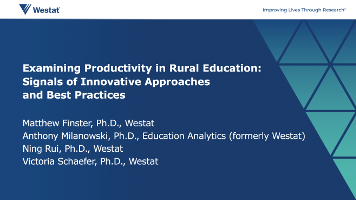Examining Productivity in Rural Education: Signals of Innovative Approaches and Best Practices
Matthew Finster, Westat
Wednesday, August 1, 11:30-12:00, SUB Ballroom D, Theme: Practice
Expectations for student performance continues to rise while many school districts are facing constrained budgets requiring school leaders to be more productive -- increasing outcomes for a given expenditure. While, rural districts and schools are often considered less productive than urban and suburban counterparts, exhibiting, on average, lower returns on investment (ROI), an analysis by Roza (2015) using national data from the United States demonstrates that one in five rural remote districts actually have a high ROI. These productive “bright spots” may provide valuable lessons about innovation and best practices. Using Wisconsin state data for elementary and middle schools (N = 2,114), we examine whether rural schools are more productive on average than nonrural schools, based on an ROI index that incorporates district expenditures and school-level value-added (VA) estimates, and the extensiveness of highly productive rural schools. While most ROI studies use measures of student achievement, which are highly correlated with socio-economic status and prior attainment, using school-level VA estimates in an ROI index provides a measure of student learning relative to education expenditures. The results of the multilevel regression analysis indicate that, on average, there are not statistically significant differences between schools’ productivity levels by locale; however, approximately one in five rural elementary schools were identified as being highly productive. Further examination of school-level funding allocations, service delivery models, and instructional practices in these bright spots may provide new insights into productivity and innovation in rural settings.
Presentation materials for download if you wish:
Click an image to download the document. This file may download immediately, or may require clicking on an additional button to download, depending on your browser.

